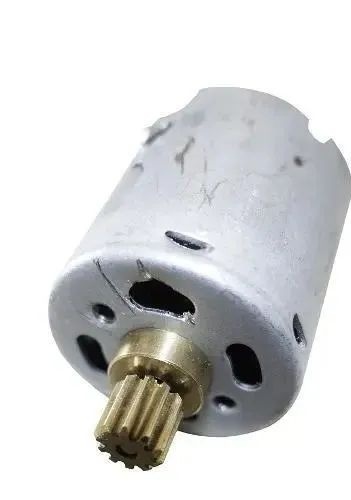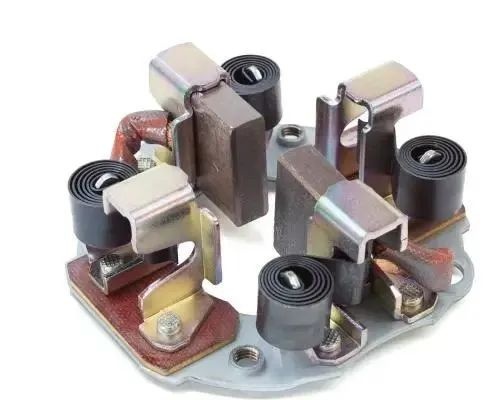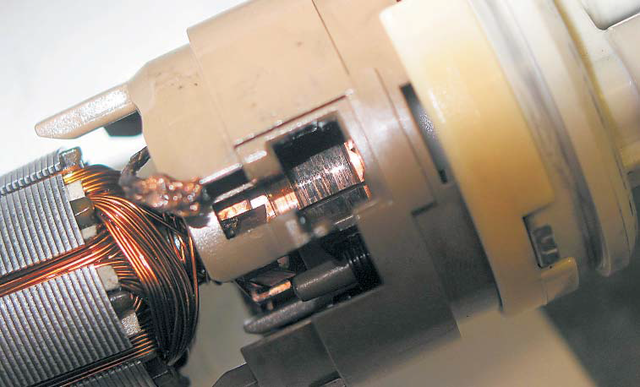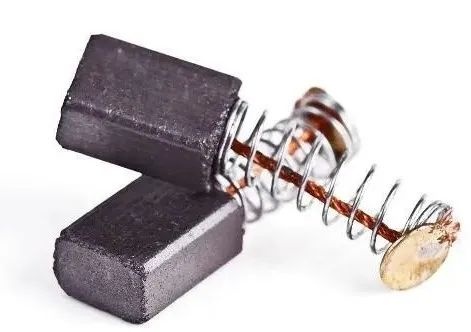Several parameters affecting the normal application of motor brushes
In electrical machines, motor brushes are used to conduct current from the stator windings to the rotor windings, they have high resistivity, brushes are also used to collect current by avoiding sparks, carbon brushes are used to make stationary wires in contact with the rotating rotor, the most commonly used is a DC motor. In order to obtain torque in the same direction throughout the rotation, the direction of the current flowing through the rotor windings must be reversed every half cycle, this is called "commutation" and is achieved by supplying the rotor current through the brushes. The brushes are fixed to the stator and connected to the copper plate fixed to the rotor, and when the rotator rotates, the brushes supply the current in the correct direction.
The DC motor uses carbon brushes to prevent sparks caused by short circuit of the armature coil, two brushes are placed on the shaft, they are fixed. The short circuit current is collected from the brush terminals and supplied to the commutator, which makes the armature current unidirectional in nature. Carbon brushes are made of carbon, because carbon is a fairly good electrical conductor, and it's soft, so the contact is good, but the brushes wear out and must be replaced regularly. This is a major disadvantage of DC motors. Now we have brushless DC motors where commutation is done by power mosfets.
Parallel DC Motor
Usually has better brush life than series motors due to their lower average speed, however, if resistors are inserted in the parallel field to weaken the field strength and increase motor speed, even with standard brushes, poor commutation can result . This additional resistance changes the ampere-turns ratio relationship between the magnetic field and the armature, causing the armature coils to commutate at a less favorable location relative to the magnetic flux, which must be considered when choosing a replacement carbon brush.

Frequent starts and stops
This presents a challenge for brushes, as higher starting currents are involved, a factor that is especially noticeable on high-voltage shunt motors, in addition, starting friction considerations also have an impact on performance, selecting high-contact-drop brushes (voltage drop 1 volt or more brushes) may be more suitable. The quiet operation of the brushes depends primarily on the maintenance of uninterrupted, smooth surface contact between the brushes and the commutator. Concentricity of the commutator, brush spring pressure, and brush-to-brush holder fit are also related to quietness. When quietness is paramount, normal use brushes can be replaced with a softer grade with sufficient spring pressure to ensure adequate commutator contact.

Humidity levels affect brush wear, low wear rates depend on the formation of a conductive lubricating film on the commutator, very low humidity (high altitude) can result in brush friction and relatively rapid brush wear, as there is insufficient humidity to form the desired The film, available in special grades of brushes, should be selected for low humidity applications. On the other hand, high humidity may increase the electrolysis of the brushes, and to improve commutation in high humidity applications, brushes with a certain degree of wear are often specified.

The presence of chemical fumes, dirt, or dust is also a determining factor in brush selection. Brush rating recommendations for use in environments affected by these contaminants often include brushes with some cleaning action. Using a fully enclosed motor also helps. Prevent contamination from reaching the commutator and brushes.
The nature of the commutator surface affects the operation of the brushes
Satisfactory service requires maintaining a uniform finish and concentricity of a smooth surface, and for any reason, changes in the commutator surface characteristics will almost certainly have a significant impact on the performance of the brush and commutator system. Springs The pressure exerted by the springs holding the brushes to the commutator surface is an important consideration throughout the commutation system. For a specific spring composition, there are generally three basic spring types:
a) The coil type is cheaper and the most popular, but the contact pressure, which decreases as the brush wears out, because the spring exerts less force when it is released.
b) Roller is expensive, but the contact pressure is constant over the life of the brush due to the constant force exerted by the spring-type brush as it is coiled or unwound.
c) The relationship between the pressure and travel curve of the lever-action spring type is between the above two types.

in conclusion
The wear rate of brushes depends on many parameters (armature speed, conduction current, duty cycle, humidity, etc.), and for optimum performance, brushed and geared motors require regular maintenance, and the maintenance interval is best determined by the user.



























 XINDA
XINDA